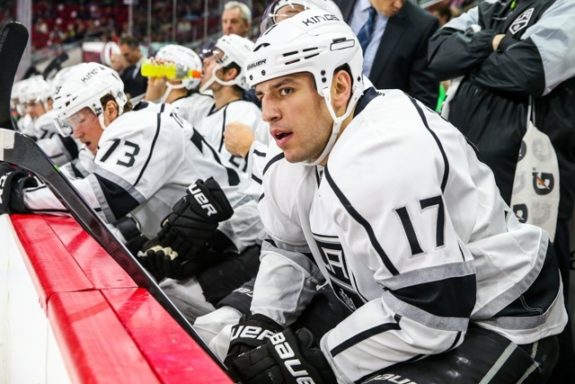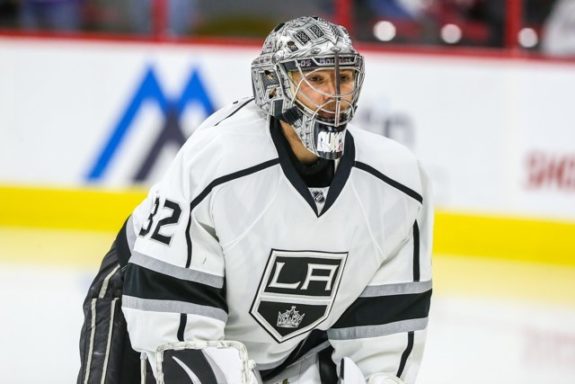The game was in extra time. The Los Angeles Kings were trying to fend off the San Jose Sharks and avoid a 0-3 hole in their opening round matchup with their California rivals. Then Dustin Brown created some room.
The Kings captain laid a hit on Sharks winger Joonas Donskoi just outside the Sharks’ blue-line which sprung Tanner Pearson on an odd-man rush. Pearson turned the corner with speed with Vincent Lecavalier on his opposite wing and only one Sharks defenseman in the zone. Pearson fired a wrister that beat Marin Jones and gave Los Angeles the 2-1 overtime win.
The win pulled the Kings back within striking distance of the Sharks going into Game 4 of their Western Conference Quarterfinal series. Now the Kings are riding the momentum as the Sharks fall down a peg. The Kings are moving forward with high hopes for the next game.
However, at the conclusion of Game 2, there was a different vibe surrounding Los Angeles. Although Games 1 and 2 were both one goal games, the Kings had been noticeably outplayed for much of the first two games and San Jose was flying high as the series moved to Northern California for Game 3.
What changed for the Kings as the series moved from Los Angeles to San Jose? Here’s where the Kings improved in Game 3:
1. Kings of the Special Teams

It’s pretty black and white. Score on the power play and keep the other team from scoring while you’re on the penalty kill and your team will be in a good position to win the game. There must have been a tutorial on this on the Kings’ charter to San Jose.
In Game 3, the Sharks, who sported the number one power-play unit in the NHL during the regular season, were held off the board on five power play opportunities which included zero shots on their final two power play opportunities of the game; a change of pace from Games 1 and 2 where the Sharks scored a goal in each game on nine chances.
While the Kings were able to shut down the Sharks’ power play unit for the first time, Los Angeles was able to continue to capitalize on their own power plays. The Kings scored power-play goals in both Games 1 and 2 on eight chances and tied game the game with a power-play goal by Anze Kopitar in Game 3.
Win the special teams battle, win the game.
2. Anze Kopitar Arrives
Continuing the talk about Kopitar, the Kings’ top player played like it in Game 3. Kopitar’s play in Games 1 and 2 was not at the level most have come to associate with the Slovenian center. Going into Game 3, the Kings needed more from Kopitar and it was apparent early that he was going to give what was needed.
Kopitar, in 6:14 of first period ice time: one goal, four shots on goal, four hits, six faceoff wins, no faceoff losses.
— Jon Rosen (@lakingsinsider) April 19, 2016
Kopitar’s final stat line boasted one goal, five hits, five shots and 65% efficiency in the faceoff circle, all done in just under 24 minutes of play. In the two games prior to Game 3, Kopitar was held to only one assist and one shot.
If the Kings want to even this series and have any playoff success really, they will need more of Game 3 Kopitar and none of Games 1 and 2 Kopitar.
3. Location, Location, Location
The biggest thing that helped the Kings turn the page after Games 1 and 2 could be the fact that the game was taking place in San Jose.
The Sharks were the NHL’s best team when on the road during the regular season. The Sharks were 28-10-3 when away from SAP Center. That trend continued as San Jose opened the playoffs with two wins on the road in Los Angeles.
Then the series shifted to San Jose for Game 3 where the team’s lackluster performances at home transferred over from the regular season. During the regular season, the Sharks posted a below .5oo winning percentage, with a record of 18-20-3. Now the Sharks have a 0-1 record while in San Jose during these playoffs.
If the trend continues for the Sharks, maybe home ice advantage for the Kings will actually turn into a road ice advantage for the Sharks.

4. Running On All Cylinders
Outside of Kopitar, the players that are supposed to do the heavy lifting for Los Angeles did so in Game 3.
Milan Lucic had the primary assist on Kopitar’s power-play goal, Drew Doughty seemed to be on the ice every other shift and had over 35 minutes of ice time, Jonathan Quick, outside of the game-opening shot which beat him, had a stellar game where he turned away 26 of 27 shots and the Kings got a game-winning goal from Pearson.
It was a complete effort from Los Angeles. The Kings were able to overcome an early goal that could have derailed the team under a minute into the game, got complete efforts from their star players and won the special teams battle. Overall, this could be an effort that may swing the momentum their way as they move towards Game 4.